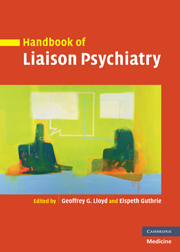Book contents
- Frontmatter
- Contents
- List of contributors
- Preface
- Part I Basic skills
- 1 The development of general hospital psychiatry
- 2 Establishing a service
- 3 Legal and ethical issues in liaison psychiatry
- 4 Understanding psychological reactions to physical illness
- 5 Detection of psychiatric disorders in the general hospital
- 6 The role of the nurse in liaison psychiatry
- Part II Common psychiatric problems across the general hospital
- Part III Working with specific units
- Part IV Treatment
- Part V Different treatment settings
- Index
- References
5 - Detection of psychiatric disorders in the general hospital
from Part I - Basic skills
Published online by Cambridge University Press: 10 December 2009
- Frontmatter
- Contents
- List of contributors
- Preface
- Part I Basic skills
- 1 The development of general hospital psychiatry
- 2 Establishing a service
- 3 Legal and ethical issues in liaison psychiatry
- 4 Understanding psychological reactions to physical illness
- 5 Detection of psychiatric disorders in the general hospital
- 6 The role of the nurse in liaison psychiatry
- Part II Common psychiatric problems across the general hospital
- Part III Working with specific units
- Part IV Treatment
- Part V Different treatment settings
- Index
- References
Summary
Introduction
Trainees in liaison psychiatry are frequently surprised to find that the detection and management of psychiatric disorders in the general hospital is a complex and time-consuming process. Liaison psychiatrists need to integrate a broad range of skills – communication, clinical, diagnostic, medical, legal and pharmacological. Interviewing patients in challenging situations, for example on intensive care units or following maxillo-facial surgery, requires the development of unique clinical skills and a certain amount of improvisation. This chapter considers those aspects of psychiatric assessment that are unique to the general hospital, and offers guidance on the assessment of the most prevalent psychiatric symptoms. The supportive use of objective questionnaires is also considered.
Clinical skills
Information gathering
The assessment process starts as soon as the referral is received. Ideally, the referral should ask a specific question about a patient's psychological health, or ask for guidance on the psychological components of a more complex management problem (for example in situations where capacity to consent is a problem). Often, a telephone call to the referrer clarifies the nature of the clinical conundrum, and it helps establish whether the referral has been made with the agreement of both the patient and the patient's senior physician. Previous psychiatric notes should be obtained at this stage.
It is essential to telephone the ward prior to the consultation to establish a mutually convenient time for both the patient and the ward staff.
Keywords
- Type
- Chapter
- Information
- Handbook of Liaison Psychiatry , pp. 83 - 101Publisher: Cambridge University PressPrint publication year: 2007
References
- 1
- Cited by



